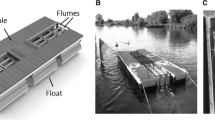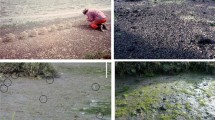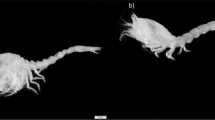Abstract
Population dynamics of invasive species can exhibit rapid population growth followed by rapid decline. Populations of Potamopyrgus antipodarum, an invasive gastropod native to New Zealand, can follow this pattern, but potential mechanisms are unclear. We assessed the biomass of P. antipodarum and native macroinvertebrates over 16 years in Polecat Creek Wyoming (USA), a spring-fed tributary of the Snake River. We documented a 15-fold drop in the biomass of P. antipodarum. Biomass of collector–filterers fluctuated in the opposite direction to that of P. antipodarum biomass, suggesting the invasive snails may suppress taxa in this functional feeding group. Because the biomass of planarians (turbellarian flatworms) fell sharply with the biomass of P. antipodarum, and because planarians (Dugesia spp.) prey on P. antipodarum, we also evaluated the functional response of Dugesia to the invasive snails and estimated predation rate. To assess whether predation by Dugesia could have caused the large drop in biomass of P. antipodarum, we used monthly matrix projection models and their periodic matrix products to estimate the annual population growth rate (\(\lambda\)) of P. antipodarum with and without predation. When we added predation by planarians to the matrix population models, we observed that the proportion of models with \(\lambda < 1\) increased by \(\approx \,{8}\%\) at most. Thus, Dugesia may shift the population from growing to declining, but predation alone probably did not explain the large decline of P. antipodarum in Polecat Creek.




Similar content being viewed by others
References
Aanes R, Saether BE, Øritsland NA (2000) Fluctuations of an introduced population of Svalbard reindeer: the effects of density dependence and climatic variation. Ecography 23(4):437–443
Adema CM, Lun CM, Hanelt B, Seville RS (2009) Digenean trematode infections of native freshwater snails and invasive Potamopyrgus antipodarum in the Grand Teton National Park/John D. Rockefeller Memorial Parkway Area. J Parasitol 95(1):224–227
Bolker BM (2008) Ecological models and data in R. Princeton University Press, Princeton
Canty A (2017) boot: Bootstrap Functions. R package version 1.3-20
Carlsson NO, Sarnelle O, Strayer DL (2009) Native predators and exotic prey: An acquired taste? Front Ecol Environ 7(10):525–532. https://doi.org/10.1890/080093
Carlsson NO, Bustamante H, Strayer DL, Pace ML (2011) Biotic resistance on the increase: native predators structure invasive zebra mussel populations. Freshw Biol 56(8):1630–1637
Caswell H (2001) Matrix population models. Oxford University Press, Oxford
Corless RM, Gonnet GH, Hare DE, Jeffrey DJ, Knuth DE (1996) On the LambertW function. Adv Comput Math 5(1):329–359
Coulaud R, Mouthon J, Quéau H, Charles S, Chaumot A (2013) Life-history phenology strongly influences population vulnerability to toxicants: a case study with the mudsnail Potamopyrgus antipodarum. Environ Toxicol Chem 32(8):1727–1736
Efron B, Tibshirani R (1986) Bootstrap methods for standard errors, confidence intervals, and other measures of statistical accuracy. Stat Sci 1(1):54–75
Gérard C, Hervé M, Hechinger RF (2018) Long-term population fluctuations of the exotic New Zealand mudsnail Potamopyrgus antipodarum and its introduced aporocotylid trematode in northwestern France. Hydrobiologia 817(1):253–266
Gervasi V, Nilsen EB, akan Sand H, Panzacchi M, Rauset GR, Pedersen HC, Kindberg J, Wabakken P, Zimmermann B, Odden J (2012) Predicting the potential demographic impact of predators on their prey: a comparative analysis of two carnivore-ungulate systems in Scandinavia. J Anim Ecol 81(2):443–454
Gilg O, Hanski I, Sittler B (2003) Cyclic dynamics in a simple vertebrate predator–prey community. Science 302:866–868
Gust M, Buronfosse T, Geffard O, Mons R, Queau H, Mouthon J, Garric J (2010) In situ biomonitoring of freshwater quality using the New Zealand mudsnail Potamopyrgus antipodarum (gray) exposed to waste water treatment plant (WWTP) effluent discharges. Water Res 44(15):4517–4528
Hall RO, Dybdahl MF, VanderLoop MC (2006) Extremely high secondary production of introduced snails in rivers. Ecol Appl 16(3):1121–1131
Halpern CB (1989) Early successional patterns of forest species: interactions of life history traits and disturbance. Ecology 70(3):704–720
Harding JM (2003) Predation by blue crabs, Callinectes sapidus, on rapa whelks, Rapana venosa: Possible natural controls for an invasive species? J Exp Mar Biol Ecol 297(2):161–177
Hemphill N (1988) Competition between two stream dwelling filter-feeders, Hydropsyche oslari and Simulium virgatum. Oecologia 77(1):73–80
Herbst DB, Bogan MT, Lusardi RA (2008) Low specific conductivity limits growth and survival of the New Zealand mud snail from the Upper Owens River, California. West North Am Nat 68(3):324–333
James MR, Hawes I, Weatherhead M, Stanger C, Gibbs M (2000) Carbon flow in the littoral food web of an oligotrophic lake. Hydrobiologia 441(1):93–106
Jensen A, Forbes VE, Parker ED (2001) Variation in cadmium uptake, feeding rate, and life-history effects in the gastropod Potamopyrgus antipodarum: linking toxicant effects on individuals to the population level. Environ Toxicol Chem 20(11):2503–2513
Jeschke JM, Tollrian R, Ranta E (2005) Effects of predator confusion on functional responses. Oikos 111(3):547–555
Juliano SA (2001) Nonlinear curve fitting: predation and functional response curves. In: Scheiner SM, Gurevitch J (eds) Design and analysis of ecological experiments. Oxford University Press, Oxford, pp 178–196
Kanehl PD, Lyons J, Nelson JE (1997) Changes in the habitat and fish community of the Milwaukee River, Wisconsin, following removal of the Woolen Mills Dam. North Am J Fish Manag 17(2):387–400
Keane RM, Crawley MJ (2002) Exotic plant invasions and the enemy release hypothesis. Trends Ecol Evol 17(4):164–170
Kerans BL, Dybdahl MF, Gangloff MM, Jannot JE (2005) Potamopyrgus antipodarum: distribution, density, and effects on native macroinvertebrate assemblages in the Greater Yellowstone Ecosystem. J North Am Benthol Soc 24(1):123–138
Klemola N, Andersson T, Ruohomäki K, Klemola T (2010) Experimental test of parasitism hypothesis for population cycles of a forest lepidopteran. Ecology 91(9):2506–2513
Ladle M, Cooling DA, Welton JS, Bass JAB (1985) Studies on Chironomidae in experimental recirculating stream systems. II. The growth, development and production of a spring generation of Orthocladius (Euorthodadius) calvus Pinder. Freshw Biol 15(2):243–255
Lake PS, O’Dowd DJ (1991) Red crabs in rain forest, Christmas Island: biotic resistance to invasion by an exotic snail. Oikos 62(1):25–29
Lefkovitch LP (1965) The study of population growth in organisms grouped by stages. Biometrics 21(1):1–18
Líznarová E, Pekár S (2013) Dangerous prey is associated with a type 4 functional response in spiders. Anim Behav 85(6):1183–1190
Moore JW, Herbst DB, Heady WN, Carlson SM (2012) Stream community and ecosystem responses to the boom and bust of an invading snail. Biol Invasions 14(11):2435–2446
Morris WF, Doak DF (2002) Quantitative conservation biology. Oxford University Press, Oxford
Pickavance JR (1971) The diet of the immigrant planarian Dugesia tigrina (Girard): I. Feeding in the laboratory. J Anim Ecol 40(3):623–635
Pritchard DW, Paterson RA, Bovy HC, Barrios-O’Neill D (2017) Frair: an R package for fitting and comparing consumer functional responses. Methods Ecol Evol 8:1528–1534
R Core Team (2017) R: a language and environment for statistical computing. R foundation for statistical computing, Vienna, Austria
Reynoldson TB, Piearce B (1979) Predation on snails by three species of triclad and its bearing on the distribution of Planaria torva in Britain. J Zool 189(4):459–484
Ribi G (1986) Within-lake dispersal of the prosobranch snails, Viviparus ater and Potamopyrgus jenkinsi. Oecologia 69(1):60–63
Rigby MC, Jokela J (2000) Predator avoidance and immune defence: costs and trade-offs in snails. Proc R Soc Lond B Biol Sci 267(1439):171–176
Riley LA, Dybdahl MF, Hall RO Jr (2008) Invasive species impact: asymmetric interactions between invasive and endemic freshwater snails. J North Am Benthol Soc 27(3):509–520
Rogers D (1972) Random search and insect population models. J Anim Ecol 41(2):369–383. https://doi.org/10.2307/3474
Schindler DW (1974) Eutrophication and recovery in experimental lakes: implications for lake management. Science 184(4139):897–899
Schmitt C, Vogt C, Van Ballaer B, Brix R, Suetens A, Schmitt-Jansen M, De Deckere E (2010) In situ cage experiments with Potamopyrgus antipodarum—a novel tool for real life exposure assessment in freshwater ecosystems. Ecotoxicol Environ Saf 73(7):1574–1579
Simberloff D, Gibbons L (2004) Now you see them, now you don’t!-population crashes of established introduced species. Biol Invasions 6(2):161–172
Sluys R, Vila-Farré M, Álvarez-Presas M, Riutort M, Kawakatsu M, Tulp AS (2015) The diet and distribution of Pentacoelum kazukolinda (Kawakatsu & Mitchell, 1984), a maricolan planarian with a freshwater ecology. Zool Scr 44(1):72–91
Strayer DL, D’Antonio CM, Essl F, Fowler MS, Geist J, Hilt S, Jarić I, Jöhnk K, Jones CG, Lambin X (2017) Boom-bust dynamics in biological invasions: towards an improved application of the concept. Ecol Lett 20(10):1337–1350
Twardochleb LA, Novak M, Moore JW (2012) Using the functional response of a consumer to predict biotic resistance to invasive prey. Ecol Appl 22(4):1162–1171
Ulm K (1990) Simple method to calculate the confidence interval of a standardized mortality ratio (SMR). Am J Epidemiol 131(2):373–375. https://doi.org/10.1093/oxfordjournals.aje.a115507
Vermeij GJ (1987) Evolution and escalation. Princeton University Press, Princeton
Vucic-Pestic O, Birkhofer K, Rall BC, Scheu S, Brose U (2010) Habitat structure and prey aggregation determine the functional response in a soil predator–prey interaction. Pedobiologia 53(5):307–312
Winterbourn MJ, Fegley A (1989) Effects of nutrient enrichment and grazing on periphyton assemblages in some spring-fed, South Island streams. N Z Nat Sci 16:57–65
Zounkova R, Jalova V, Janisova M, Ocelka T, Jurcikova J, Halirova J, Giesy JP, Hilscherova K (2014) In situ effects of urban river pollution on the mudsnail Potamopyrgus antipodarum as part of an integrated assessment. Aquat Toxicol 150:83–92
Zuharah WF, Lester PJ (2010) Are exotic invaders less susceptible to native predators? A test using native and exotic mosquito species in New Zealand. Popul Ecol 53(2):307–317
Acknowledgements
We thank Kara Wise, Meghan Bochanski, Jaide Phelps, Rachel Wieseman, Holly Copeland, Scott Copeland, Jessica Liffrig, Sarah Sheehan, Maria Quispe, and Matt Legersky for assistance in the lab and field. We thank UW-NPS Research Station directors Harold Bergman and Michael Dillon for providing housing during field studies. Special thanks to Alex Buerkle for computational consultation. We also thank Associate Editor Dr. Robert H. Crowie, our Associate Editor, for his careful and thoughtful edits and suggestions. This research was made possible with funding from the Berry Graduate Fellowship, UW-NPS Research Station, and the Zoology and Physiology Department at the University of Wyoming.
Author information
Authors and Affiliations
Corresponding author
Ethics declarations
Conflict of interest
The authors declare that they have no conflict of interest.
Additional information
Publisher's Note
Springer Nature remains neutral with regard to jurisdictional claims in published maps and institutional affiliations.
Rights and permissions
About this article
Cite this article
Greenwood, D.J., Hall, R.O., Tibbets, T.M. et al. A precipitous decline in an invasive snail population cannot be explained by a native predator. Biol Invasions 22, 363–378 (2020). https://doi.org/10.1007/s10530-019-02093-8
Received:
Accepted:
Published:
Issue Date:
DOI: https://doi.org/10.1007/s10530-019-02093-8




